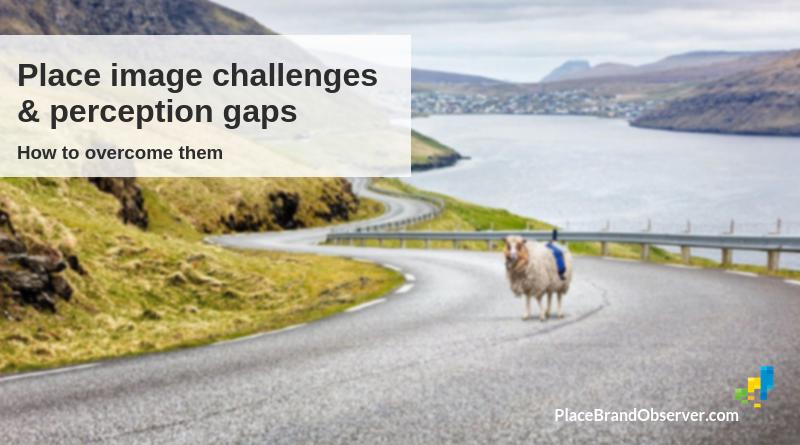How can cities, regions or countries overcome image challenges? How to bridge perception gaps? Intriguing questions from our readers which we put to our panel of place branding specialists. Below their answers (in alphabetical order – highlighted respondents are available for consulting, research or as speakers).
A few key takeaways:
- Changing perceptions of a place takes time – sometimes even decades.
- Social media are an important tool and influencing factor for place image.
- Education works well against misperceptions.
- Be true to and engaging with your target audiences. No point putting lipstick on a pig.
- Focus on storytelling. Providing evidence and facts is important, but not enough.
- Action – new policies, initiatives, placemaking – speaks louder than words.
Aparna Sharma
This was the starting point of the brand campaign for India Brand Equity Foundation in early 2000, when the Foundation was established. It was also the time when the Indian IT sector was making waves, particularly in overseas markets. Yet, almost all the articles in newspapers and magazines abroad, when reporting on Indian IT, carried images of bullocks carts, stalk poverty and so on.
Managing image perception demanded sustained engagement with editorial teams, offering customised Experience India visits (seeing is believing), and a dynamic website. What it also meant was saying no to umpteen requests for being part of Festivals of India overseas that wanted to carry the old images of India and not the fast changing face of India.
 Bill Baker
Bill Baker
Total Destination Marketing / Speaker profile
Outdated and inaccurate perceptions frequently prove slow and stubborn to remove. It may have taken decades, or maybe even centuries, to form a city’s current image. And we know that the “old brain” is much stronger and more inflexible than the “new brain” when it comes to replacing old impressions with new. Therefore, it’s tough to change perceptions and image of a place overnight.
Turning around perceptions takes time and a combination of marketing communications, positive word of mouth (or social media) and consistently positive first-hand experiences with the location.
Ed Burghard
For misperceptions, the solution is education. For valid negative perception challenges the solution is placemaking. Never try to put lipstick on a pig. Acknowledge and deal effectively with valid criticisms.
Eduardo Oliveira
In my opinion, closing the gap between place branding and spatial planning and placemaking is very important to overcome place-image challenges. If we understand place branding as referring to the creation of value in space by reinforcing and representing the assets of the place in a cohesive manner, in an image and in a narrative of the place itself, it must be developed in cooperation with domains of policy-making and, most importantly, with the values and desires of the community at large. When place branding strategies are closely linked with local perceptions of assets and narratives of place, then place branding can make spatial planning and placemaking more sensitive to value creation and to the perceptions people may hold of a place.
In summary, place branding should explore synergies with spatial planning and spatial governance to align interests, visions, perceptions and thus solidify a place image rooted in community values.
 Christopher Hire
Christopher Hire
The key is to not contradict or treat visitors as stupid, or as if they are just a source of funds.
Many brands try to milk tourists and our data shows city brands are being impacted by not being current with messages – that is, just milking the cash cow of an old brand.
Gregory Pomerantsev
The factors that have a primary impact on the formation of the image of a country, city or region are image communications and concepts such as government policy, national identity, international relations, mass media and PR technologies.
PR seems to be the most significant factor in bridging perception gaps and overcoming image challenges. Public relations activities are most instrumental in conveying the idea of a brand or image to the public through media. Transmission of such ideas stimulates the audience to accept them as decisions that contribute to the formation of preference for certain events, phenomena, objects.
When changing the country’s image, PR events are designed to transform attitudes towards a particular country in a social environment: change hostility to sympathy, prejudice to consent, apathy to interest, ignoring information to active search for it.
 Jeannette Hanna
Jeannette Hanna
Trajectory Brand Consultants / Speaker profile
First of all, be clear what the image challenges are and who they impact. An image of a place that’s “unsafe” is different from a place that’s highly bureaucratic and difficult to do business with. Start with stories. There’s lots of research to suggest that the narrative people believe about their “place” – positive or negative – plays a huge part in determining their future. We’ve worked with locales with many great assets but a deeply skeptical, “downbeat” collective mythology that “nothing can change here.” Even when presented with strong evidence of economic development successes, sometimes local influencers don’t believe the facts. So it’s key to directly address a community’s sense of impotence. Igniting community pride can be a very potent force. Reinforcing stories of collective empowerment and transformation, as Abraham Lincoln might say, draw on “the better angels of our nature.”
At its nadir of economic blight, Detroit started to build momentum around the ingenuity of creative entrepreneurs and brands like Shinola that have built on the Detroit-tough image.
The first seeds of change always come from the ability to reimagine possibilities. Congress heights, a predominantly African American neighborhood in Washington DC, has been marginalized by urban blight, crime and racism for generations. When the zeitgeist of a place is relentlessly negative, fatalism can cripple ambition. Through a series of community workshops, community organizers rallied residents around a push to celebrate the area’s rich African American heritage, culture and local entrepreneurs. Focusing on local empowerment, we worked with community organizers to help them redefine, and celebrate, their place as a distinct neighborhood within DC. Today, you’ll see it everywhere, even stencilled on sidewalks – Soul of the City. As locals assert their vision for the future, city officials and private developers are responding positively to the area’s assertiveness and collective sense of ambition. For the first time, Congress Heights is being invited to collaborate in long-term planning initiatives and policy development that will shape its trajectory as a vital layer in DC’s future growth.
Jeremy Tamanini
Can image challenges be overcome without social media? Social media have democratized information exchange. So “official” campaigns by places can easily be delegitimized (justifiably or not) through social media conversation. Places with image challenges could create experiences that lend themselves positively to social media posting and sharing. If possible, these experiences should be designed to counter existing negative perceptions.
 Joao Freire
Joao Freire
Grounded Brands / Researcher profile
First, it is important to know the current image with the relevant users; and then it is critical to understand how the place wants to be perceived by the target users. Once we have these two elements defined, we then have to be realistic in terms of what can be achieved within the time period and the planned budget, as well as clearly defining for which users the organization wants to reduce the gap. For some users the perception gap between the stereotypes and reality can be so great that the investment needed to reduce the gap might not be worth it in the short and medium term.
Jonathan McClory
It can’t be done through branding and marketing alone. It’s best done through action – new policies, new initiatives, that can then be leveraged to change the narrative of a place. People need to see it, to believe it. A rebrand and marketing campaign can’t make up for the concrete challenges that are ultimately the root cause of an image problem. Where a rebranding and strategic communications effort can help is when there is a new story to tell, underpinned by real change.
José Pablo Arango
This is our everyday task as place branders. The image of a territory is the product of a very large number of uncontrollable variables. You have to focus on what makes the difference and what is relevant to the audience.
 Juan Carlos Belloso
Juan Carlos Belloso
This is what place branding is all about: building or changing perceptions about a place or a destination. Normally there is a ‘gap’ between current image (perception) and the reality of a place, which tends to be negative. Sometimes we just want to build new perceptions about our place. And as we know we have many tools to do that, starting by changing the reality of a place or using different tools that would help generating and changing perceptions.
We build our image of a certain place based on existing clichés, stereotypes and also on personal experiences with the place, through references from friends and opinion leaders, through media, etc., and changing perceptions takes time. A place can change its reality over time, but changing our perception about that place will take longer. This is why we need to understand current image (perception) and desired image, and define a consistent strategy over time to build or change perception.
 Martin Boisen
Martin Boisen
For the love of place / Researcher profile
First of all, one must be sure that the challenges are, in fact, image challenges. Too often, clients simply assume that we’re looking at a perception gap, whereas the cause might be a performance gap. If left unaddressed, this almost certainly results in wrong priorities and wrong interventions.
Second, one must critically assess how big of a problem this really is and why. Again, the magnitude of the problem might be based on an untested and unchallenged assumption.
In my experience, major problems with image are grounded in real problems – and in that case the root of those problems must be addressed, not only the symptoms.
Generally speaking, the most effective way to address image challenges is not to launch promotional campaigns, but to do stuff: deliver proof that the image is wrong and let that proof speak for itself. Consistent behavior is the way to change an image.
 Pärtel-Peeter Pere
Pärtel-Peeter Pere
DO things that will earn you a better reputation. Once you are d o i n g things, get creative with the marketing.
 Robert Govers
Robert Govers
Independent advisor / Speaker / Researcher
Isn’t that what the whole field of place branding is about? So reading TPBO is a good start 😉
Sebastian Zenker
First, get aware of them (that is, measure the brand as brand image perception).
There are aspects you have to accept and rather work with (especially if the image is strongly rooted) – and other aspects, where communication “easily” can change and reduce the image gap.
However, especially external target groups will always have a reduced and more “stereotype” image of a place. This is something you have to accept.
Todd Mayfield
Understanding that a community’s image is determined by the perception others have of you, despite your best intentions, well conceived communications only do so much. They amount to “the promise made”. The experiences visitors have while in a community must amount to “the promise kept”, in order to complete the loop.
Place branding is a holistic process. A place brand’s value requires two sides of the coin. If the desired brand message does not match the experiential reality, then a bigger initiative is necessary. Old perceptions come from past experiences. Urban infrastructure, efficient wayfinding, destination quality and front-line visitor service interaction must be in concert with the brand platform and messaging.
Old perceptions take time to change. This must be driven by a central authority who is fully vested in the brand’s vitality for the long term.
 Tom Buncle
Tom Buncle
Listen to customers. Fight ignorance with evidence – research always trumps opinion.
Previous questions answered by the panel here
You’d like to ask the panel a question? Get in touch!
Enjoyed this snapshot of expert views on how place branding can help to bridge perception gaps and address image challenges? Spread the word!


